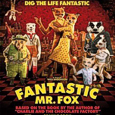20th Century Fox (October 23 2009), 20th Century Fox Home Entertainment (March 23 2010), Blu-ray plus DVD and Digital Copy disc, 87 mins plus supplements, 1080p high-definition 1.85:1 widescreen, DTS-HD 5.1 Master Audio, Rated PG, Retail: $39.99
Storyboard:
Roald Dahl’s novel comes to life in the latest screen adaptation of his work, a unique stop-motion telling of the story of a wily fox who pulls off one last caper in order to get one over on a trio of dastardly farmers out to capture him.
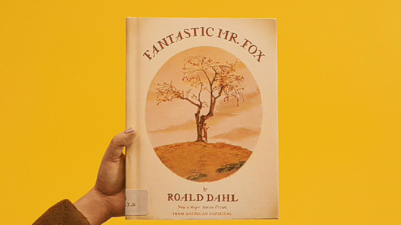
The Sweatbox Review:
Despite the aggravated proclamations of its animators and heavily dropped rumors that director Wes Anderson was hardly to be seen on the “set” of this stop-motion animated adaptation of Roald Dahl’s Fantastic Mr. Fox, there is, ultimately, no question whose film this most certainly is when regarding the final result. Anderson says he “lived” the production for two years, and it’s clear he certainly supervised the vocal recordings, but while his thumbprints may not show up on the characters’ animation itself, his fingers are all over the rest of the movie, from its visual design to the music and editing.
Over a long career that has only yielded a handful of films (Mr. Fox is only Anderson’s sixth film in fifteen years), I can’t say that each and every one has made its mark on me. His debut, Bottle Rocket, didn’t take off for me, despite the pairing of the Owen brothers and their off and on-screen collaboration on the film. Rushmore, the first of which one might recognize as a “Wes Anderson movie”, had a fine and quirkily funny central conceit, but Jason Schwartzman’s character was too distant to ever really connect with and the film was more notable for finally outing Bill Murray as an actor of note.
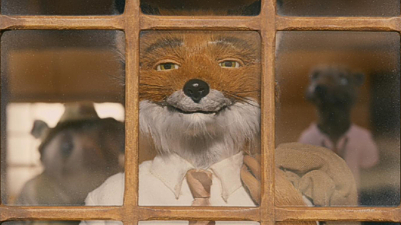
Anderson’s next, The Royal Tennenbaums, was a bull’s eye hit, and his tale of an extended family with labyrinthine issues was rewarded with very good notices and decent box office, boosted by writing that was strong and focused, and an amazing line-up of names in a powerhouse cast that included Gene Hackman in one of his more significant final roles. The family unit dynamic was again a major element of The Life Aquatic With Steve Zissou, in which Murray played a Cousteau-like documentarian out for somewhat subdued revenge against the shark that ate his filmmaker partner.
The underwater scenes were notable for featuring the stop-motion creatures of Henry Selick, bringing a fantasist angle to another idiosyncratic story, and though the film didn’t appeal to everyone, it is perhaps my favorite of Anderson’s live-action work, the poorly received The Darjeeling Limited from three years ago proving to be a little too complacent even for long-time followers. Selick was also in the frame to direct Fantastic Mr. Fox (having also directed the much-praised adaptation of Dahl’s James And The Giant Peach), although it was perhaps a combination of the time it took the project to come together and, possibly, Anderson’s insistent nature that caused him to drop out and pursue the more personal Coraline instead.
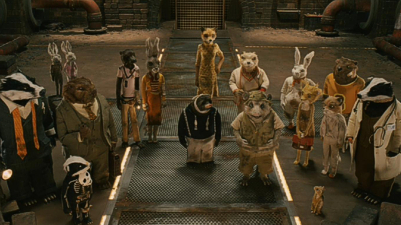
Anderson resisted the temptation to go for computer animation and retained Selick’s medium of choice, stop-motion, shooting the film just outside London at the Three Mills Studios, with much of the same crew as worked there on Tim Burton’s Corpse Bride. Given these British connections, not least Dahl’s original story, there’s a distinct Brit-feel to Mr. Fox, despite the mix of voices. Various Anderson regulars, joined by a top-lining George Clooney and an unrecognizable Meryl Streep as Mr. and Mrs. Fox respectively, fill the roles, with a returning Schwartzman especially good as their distant son. Of course, the villains, a trio of farmers out to catch Mr. Fox and stop his raiding and looting, are English, led by Michael Gambon, here forgoing the soft tones of Professor Dumbledore and playing up his unhinged wide boy criminal type as seen recently in Layer Cake and the underrated comedy High Heels And Low Lifes.
Gambon is one of the most realistic villains in recent animated film, losing an early comic slant to become truly ruthless and the somewhat terrifying ringleader of the farmers; his destroying of his office at a point of frustration is unexpected and a great bit of animation. But regardless of the mixed accents, Mr. Fox works in that way that didn’t affect the likes of The Jungle Book, or The Lion King, where many dialects all seemed to be able to coexist in far off continents, and although a particular setting is never specifically mentioned, Mr. Fox’s impressive sets and almost knitted fields indicates that we’re still firmly in the English countryside. If the film comes close to anything, it’s the feel of Aardman Animation’s Chicken Run, which apart from the medium, Mr. Fox seems to share a lot with in tone.
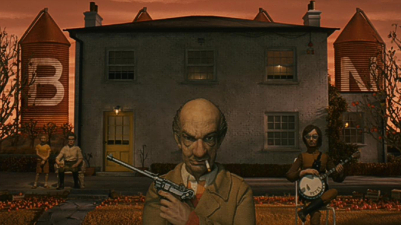
So here, instead of Mel Gibson’s plucky rooster, we have Clooney’s wily Mr. Fox, shooting out dialogue like James Cagney. He heads up another noteworthy Anderson ensemble that also includes Owen Wilson, and, inevitably, Bill Murray, all of whom never steal the show away from their characters and all of which, remarkably for a celebrity cast, fit their personalities like a tailored glove. There are opportunities for clever language and witty wordplay, but this only ever gets near the mark (“We’ll shoot the cuss!”) and never crosses any lines that tips it into adult territory. That the cast are also often asked to relay sometimes quite banal and everyday dialogue, delivered with speed and gusto, is exactly what makes Fantastic Mr. Fox both down to Earth, but wonderfully different from other animated pictures – especially the cut and paste antics of many shiny CG films – at the same time.
Another element towards this reaction is the truly handcrafted nature of the models and animation. While everything is super-slick and fluidly animated, there’s a slight art-house European animation sensibility to the characters, their clothing ruffled around by the animators’ hands, though giving the foxes the constant appearance of wind blowing through their fur. This brings a stylized but highly naturalistic look to the production, especially the human figures, and even though the animals routinely wear clothing and live in “houses”, they are clearly still animals, especially when they eat and when in accelerated motion, cleverly moving with fluid yet staccato actions that keep the characteristics between animal and man distinct.

These touches extend to the staging of the film, and here again Anderson’s visual ingenuity comes to the fore. Some of these tricks are old trademarks (the use of a book to highlight the main title, the typically direct and symmetrical framing, and the illustrated descriptions of setting plans into motion) and some of them are new slants: the side-section views of various locations, especially to depict the animals tunnelling, which is somewhat odd in appearance and shouldn’t technically work, but has a innate charm to the process, as does the rest of this film. You may well have seen films that look like this, but you’ve never seen a film quite like this before.
For me, the one weak link is Willem Dafoe as a security rat, a personality not as clever or witty as the film thinks he is, and the ultimate resolution of the character doesn’t have the impact that it should. But even here there seems to be some playing with other levels: like or loathe the character, it’s hard not to see the fun in the rat’s sharp teeth, reminiscent of Dafoe’s own role as Max Schreck in the account of filming Nosferatu, the deeply comical Shadow Of The Vampire, and furthering Dahl’s British influence is the wannabe singer Petey, voiced, and caricatured from, Pulp front man Jarvis Cocker. With a terrifically tactile feel, Fantastic Mr. Fox is an immensely visual film, and like the best of Aardman, is fuelled by wonderful details; a heist pulled off and seen via several closed circuit TV monitors will especially raise a chuckle, as will a supermarket ending, reminiscent of the final shot in Raiders Of The Lost Ark.

Adapted from Dahl’s original, the story has understandably undergone some tweaks and changes, but it truly retains more than just the gist. Despite the slick cast and exuberance from Clooney, it’s still the tale of a marauding chicken thief who raises the ire of three local farmers, one of which, Bean, manages to snaggle off Fox’s tail and wear it as a tie, leading to all out “animal” warfare! The scale of these scenes is impressive, even though the film retains a highly intimate feel (the Foxes’ detailed beech tree home being based on one in Dahl’s own grounds), especially in Mr. and Mrs. Fox’s relationship, and there are great moments in the writing, such as Fox’s self-realization that he can not continue the way he has been, and the use of language, such as a Latin name roll call that is supposed to call upon the animal’s primal instincts until one of them – Murray’s lawyer – suggests his talent is “demolitions expert”!

All of which adds up to a movie that pretty much splits audiences right down the middle. It’s genuinely unique, which was rewarded by good word of mouth in its theatrical release only for extended audiences to find it too original and innovative. Fantastic Mr. Fox is unconventional, but it still delivers all the beats a mainstream commercial and critical success requires and even finds time for a selection of Anderson’s typically erratic music choices, including Burl Ives and, in a couple of nods to Disney, The Ballad Of Davy Crockett, hinting at a 1950s retro era, and Love from the Studio’s 1973 animal take on Robin Hood in which the hero was another foxy thief of course.
Fantastic Mr. Fox’s nomination in the Best Animated Feature category at the Oscars this year was justly deserved, and even if Up had it in the bag, one hopes it wasn’t left too far behind, even if Clooney’s “Hey, I thought this was a real movie” line in the category’s promo might have bruised some overly sensitive animation fan sensibilities again. Not quite the animated Ocean’s… picture it was widely described as by other reviewers due to the Clooney connection, Mr. Fox clearly bears Anderson ownership, akin to how a big, studio financed independent animated movie would turn out. That is essentially what has occurred here, along the lines of an animated Little Miss Sunshine, for instance, ironically another Fox release, and although our hero is truly a Twentieth Century Fox, the Studio’s logo does not undergo any opening shenanigans here: a missed opportunity or too obvious for a cheap gag?
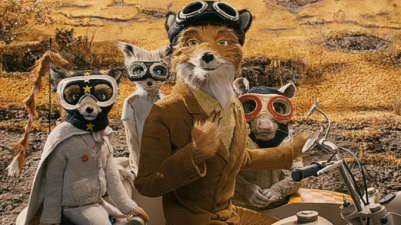
Perhaps with animation’s new found status of worth – at last – we are entering a new phase where our most inventive live-action directors have become frustrated with those limitations and have a need to explore their imaginations in a new medium. Already we’ve had Tim Burton returning to his animation roots, and even Spike Jonze has dipped in similar waters with Where The Wild Things Are, which feels like something of a kindred project to Mr. Fox. Not all these crossovers will be successful – for every Terry Gilliam professing an interest in visiting Pixar, which could be a new level for both indeed, we have once great directors and their doomed pursuit of motion-captured photorealism. I await with great interest the results of Pixar’s live-action epics 1906 (currently on hold) and John Carter Of Mars (currently shooting in London), but in the meantime, as a director who has taken the trip in the opposite direction, and however hands on or off he may have been, Mr Fox is Wes Anderson’s film, and it is Fantastic!
Is This Thing Loaded?
As more and more companies realize what a great hand Disney played with their “triple play” Blu-ray, DVD and Digital Copies, Fox continues the trend, as it did with their Ice Age: Dawn Of The Dinosaurs, by bundling all three formats into this combo pack. Anderson’s films routinely wind up heading straight for the prestigious Criterion Collection in most cases, though that Fox doesn’t have a distribution deal with them means that they’ve retained the title to deal with the extras themselves. It’s not quite a Criterion level exploration of the film – there’s an intentional or not lack of a commentary track for a start – but there’s still a well rounded look at the production to be enjoyed.
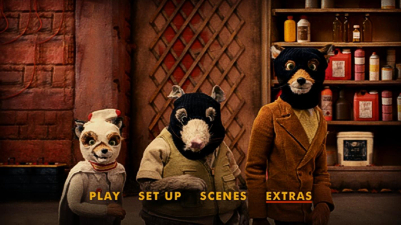
On starting the disc, previews for the very funny-looking upcoming Steve Carell/Tina Fey action comedy Date Night, the very annoying-looking Alvin And The Chipmunks: The Squeakquel and, if you can believe it, Marley And Me: The Terrible 2s play upon loading, before we’re on to the quite disappointing static and basic main menu. Here you’ll find the options for set-up as usual, though the multiple languages the disc offers means the chapter index just carries numbering system as opposed to anything more meaningful, even if there is a chance to bookmark your own favorite scenes.
The menu also makes the supplements look a little meagre at first: indeed going by the top level options you’d think there were only four extras to be had. Top of the pile is the 45-minute Making Mr. Fox Fantastic documentary in HD, which links a group of six featurettes together to provide an all-coverage exploration of the film. We begin with The Look Of Fantastic Mr. Fox, a discussion with director Anderson about his take on Dahl’s book, the elements he wanted to retain for his screen version, and the way, spending time at Dahl’s own home looking through early drafts and Dahl’s own notes, and with his widow Felicity, he managed to capture the right spirit.

From Script To Screen elaborates more on Anderson’s collaboration with his animation team, from how he thumbnailed each scene before storyboards and animatics took over, and how he “directed” the performances by way of shooting his preferred take on video for the animators to reference. Although production designer Nelson Lowry suggests not every decision was “stop-motion friendly”, he does concede that this is exactly what makes Mr. Fox a challenge and a unique project for this medium, and cast member Bill Murray puts it best when he notes that he saw the initial resistance to Anderson on set gradually turn into excitement and enthusiasm.

The visual stars of the movie, and their fabrication, maintenance and manipulation on set, are revealed in The Puppet Makers and Still Life (Puppet Animation), from initial character designs, sculpting and moulding, to an explanation of stop-motion armatures and, most interestingly, the different scale models used to depict the characters in ultra close-up (by way of an almost life-sized Mr. Fox hand), standard animating size, half-size and for wide framing, where they have been scaled to micro and mini-micro size so that they appear in scale on what would look like a huge set through the lens. Anderson explains how seeing King Kong (1933) informed the look of the animation approach in terms of the animals’ fur, and there are some great time lapse shots of the animators at work creating some scenes.
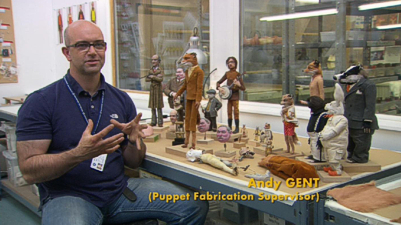
Bill Murray has already popped up on set in this footage so far, but The Cast takes a look behind the camera and into the recording booth. Despite the all-star name casts in animated films these days, there’s always a lack of focus on the voices in supplemental material, but I’m always appreciative to see more because very often this is where a lot of the characters’ personalities come from and it’s interesting seeing their approach to creating those moments. Here, the uniqueness of the visuals is matched by the “on location” vocal shoots, bringing the actors into the kinds of surroundings (a woods clearing, on a motorbike, etc) to provide the accurate timbre to the soundtrack. Murray’s the most vocal supporter of the film on camera, and his relationship with his character is observed in the final clip, Bill And His Badger, as well as a tour of the 3 Mills Studio where Mr. Fox was shot.

Though it repeats a bit of material from the film, A Beginner’s Guide To Whack-Bat (:60) explains the rules of the game Mr. Fox and his furry friends are partial to, using footage from the movie, production art and new graphics, all grunged up to feel like an old instructional movie. Feeling like an extract from the featurettes, Fantastic Mr. Fox: The World Of Roald Dahl might sound like a surprise retrospective, but it settles instead for a brief three-minute look at Dahl’s Gypsy House residence and how it inspired Anderson’s approach to the material. To be honest, there’s not much in here that hasn’t already been covered by the Dahl aspects in the documentary, but it’s nice to know that his widow feels he would have “loved” Anderson’s results.
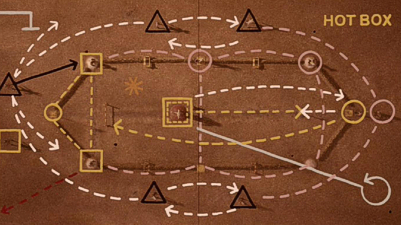
Finally, a lengthy Theatrical Trailer (2:25) does a good job of turning the quirky aspects of Fantastic Mr. Fox into what feels like a more straight-forward commercial George Clooney movie, though the marketing department’s emphasizing of the comedy, action, basic plot and all-star cast is probably what disappointed some audiences when they turned up and got something much more layered and nuanced instead. This being a combo pack, the included DVD features the movie in anamorphic widescreen, the same previews, a better menu (with scene descriptions instead of just index numbers), and a selection of the featurettes: From Script To Screen (6:56), Still Life (Puppet Animation (7:20), A Beginner’s Guide To Whack-Bat (:60), the Theatrical Trailer, and additional previews for Whip It and Fox’s Family Favorites.
Case Study:
Even though Mr Fox was justly celebrated critically, a somewhat less commercial success than was perhaps expected means the package doesn’t get the deluxe slipcover treatment the way Ice Age 3 did, arriving in a standard Blu-ray case, albeit with a striking yellow sleeve (that somewhat swamps the characters). A disc tray holds the BD and DVD, with the Digital Copy disc resting in the back of the case, while an insert at the front provides the iTunes/Windows Media file activation code and a list of further interactive bonuses to be found at the Fox Pop link online.
Ink And Paint:
The digital SLR cameras’ high-definition capturing of the frame by frame process employed by Fantastic Mr. Fox’s production crew is brilliantly detailed with fine precision on this excellent Blu-ray transfer. The film, set in the autumn, is full of auburn reds and browns, providing an automatically super-warm feel that just makes one feel cosy, but it’s the hand-crafted characters and props that really stand out among their environments. The handprints of the animators are the only real giveaway sign that the fluid movement isn’t computer enhanced, and for the clarity giving away a few tricks, such as the very wide shots featuring not fur but moulded figures of the miniature characters, there’s something else to marvel at, like the cotton wadding smoke that adds to the charm and sense of achievement. Just beautiful, and three dimensional enough without the need for glasses-wearing gimmickry.
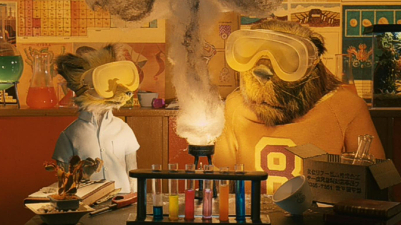
Scratch Tracks:
If there’s one minor thing to pick up on with the Mr. Fox audio it’s the sound levels, which can skip from pretty quiet for the character voices to very loud for some of Anderson’s music cue choices; The Beach Boys’ Heroes And Villains, early on, is as particularly thumping as it is exuberant, which is probably the intention even if it will sometimes blast your home theater system. The distinctive vocal recording process, where the actors were taken out into natural environments to capture their performances, delivers an intentionally different feel to the sound just as much as the eclectic cast’s off-beat performances create a magic of their own. Subs and dubs include 5.1 Dolby Digital in Spanish, French and Portuguese tracks, with English, Spanish, French, Portuguese, Cantonese and Mandarin text bundled in too.
Final Cut:
Although it didn’t entertain just as many audiences as did click in to its innate whimsical charm, Wes Anderson’s take on Roald Dahl’s Mr. Fox truly marks that rare occasion when a live-action director brings a unique, and genuinely Fantastic, new perspective to the animation medium. Taking the objective view, it’s clear that Anderson was not on set night and day, and perhaps this isn’t why he hasn’t contributed an audio commentary to this disc, and while this is a bit of a disappointment (he’s not against them, having provided remarks for previous films), it’s also hard to say what he might have brought to a track that isn’t covered in the documentary featurettes.
If there’s anything that I could say was “missing” or that would have made for an insightful extra, it would have to be the chance to view concept and character art, from Anderson’s own thumbnails through storyboard and production to publicity posters, close-up by way of still frame galleries. Fox are also usually quite hot on including the promotional programs made for TV at the time of a film’s release, and it would have been nice to have those for archival purposes, or some footage from the much-hyped London world premiere, too. But one can’t grumble too much; this is better treatment than most films get on disc, and the film itself, wearing all its hand-crafted nature on its sleeve, looks and sounds – one more time – fantastic.
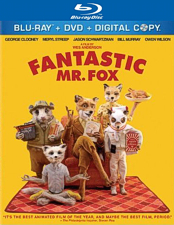 | ||
 |







